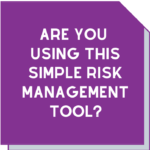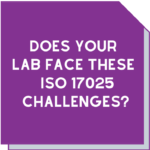Management reviews – are you doing them properly?
 Once you’ve completed your assessment visit, you may feel like you can take a deep breath and rest on your laurels for a while.
Once you’ve completed your assessment visit, you may feel like you can take a deep breath and rest on your laurels for a while.
And this is absolutely true. You certainly can do this.
For at least a couple of hours.
Because once you’ve waved goodbye to your NATA assessment team and closed the door, that’s not the end. It’s the start of another cycle.
You can consider this phase ‘maintenance and monitoring’. Of course, it’s business as usual because you’re still carrying out the work that serves your clients. Plus, there may be one or two things that the assessment team picked up that you’ll need to action.
But during this ‘live’ phase of your business, you need to be monitoring and reviewing trends in your system and responding to any issues or opportunities from this monitoring and trend analysis work. And an important part of that process is the management review.
Why should you do a management review?
No doubt you’ve read the section in the standard about management reviews. For your reference, in ISO 17025 it’s clause 8.9 or clause 4.15 in ISO 15189 (makes great reading if you can’t sleep…).
If your lab holds accreditation to ISO 17025 or ISO 15189, a management review is mandatory.
We’ll talk about inputs and outputs shortly. Essentially, what you’re looking for is anything that needs to change or improve and allocating resources for those things.
Remember, the standard doesn’t say HOW you should conduct your management review. It just says that you should. It’s up to the lab and management to decide when and how often this should take place and the format.
The key is ensuring that you act upon any decisions in a timely manner and documenting this action.
What is a management review?
The standard requires that labs review their management system at pre-planned intervals. This isn’t an audit. It’s not about reporting back or reporting measurements.
This is a tactical and strategic planning opportunity to evaluate the extent to which the management system fulfils its functions and goals.
You’re aiming to systematically evaluate the overall performance of your lab and its quality management system.
But just to be clear, this isn’t something you should be doing because NATA or your certification body requires it. Ensuring the lab’s management system is suitable, adequate, and effective is simply good business practice. And a management review should allow you to identify shortcomings and find the resources you need.
What do you need to look at?
Whilst there is a laundry list of things to cover in a management review, they boil down to four key factors to consider:
- Suitable – do the processes and operations you have in place facilitate and support the lab’s activities?
- Adequate – are all the requirements of the standard being met? Is the lab complying with regulatory and contractual requirements?
- Effective – is the management system accomplishing the stated purpose of producing the intended or expected results?
- Efficient – examine the relationship between the resources and the results being achieved.
What do I need for a management review?
We won’t go through the whole process here. That would take an e-book, not an article!
However, the ISO 17025 standard lists some mandatory inputs and outputs for your management review. There is a slightly different list in ISO 15189. We’ve listed these and included some notes for you to consider:
a) changes in relevant internal and external issues
Internal issues could include new equipment, new policies or personnel leaving and retiring. External issues include those beyond the control of the lab such as the pandemic, regulatory changes, changes to standards that are critical to your business, or perhaps a new competitor.
b) fulfilment of objectives – have you met the objectives you aimed to meet?
c) suitability of policies and procedures
Is your QMS reflecting what your lab is actually doing? Are the structure and content of the QMS documents still fit for purpose? If you have external documents incorporated in your system, are they the current versions?
d) status of actions from previous management reviews – check if those actions were assigned and accomplished. Is there anything outstanding?
e) outcomes of recent internal audits – this is a good chance to review the process as well as the outcomes
f) corrective actions
Show what these were and whether the actions were implemented and monitored. Were any repeated? Were staff aware of the process and did anything fall through the cracks? What trends can you identify?
g) assessments by external bodies
Who did this and when is the next one? Is the next one scheduled? Were there any findings and if so, why weren’t these picked up as a non-conformance during your internal audit process?
h) changes in the volume or in the range of laboratory activities
Have you detected any trends? Do you need more financial, equipment or human resources? Is there a need for more training or perhaps cross training of staff?
i) customer and personnel feedback
What are your staff telling you? How do you get feedback from them and what is that process? If you’re collecting feedback from customers, is this effective? Sending out 100 surveys but only getting one response means you need to try something else.
j) complaints
Are your complaints going to the right person? Are they being addressed according to the requirements of the standard? Have you seen any any trends?
k) effectiveness of any implemented improvement
l) adequacy of resources
m) results of risk identification
The standard mentions taking actions to address risks and opportunities. What risks did you identify? Were they taken, mitigated, or avoided?
n) outcomes of the assurance of the validity of results
Did you participate in proficiency or interlaboratory testing and if so, what were the results? Outcomes could also include QC check results, control charts or any statistical analysis you’ve done
o) other relevant factors, such as monitoring activities and training
The outputs from the management review must record all decisions and actions related to:
a) the effectiveness of the management system and its processes
b) improvement of the laboratory activities related to the fulfilment of the requirements of the Standard
c) provision of required resources
d) any need for change.
That doesn’t mean you add these items to the agenda; it’s about keeping these things in mind and clearly recording your decisions with respect to these elements.
That’s a lot of work!!
It really is. But this is also an important and valuable process that will reap benefits for your business.
However, if you need help with any of it, we’re right here for you.
Maree is a highly experienced consultant and facilitator with years of practical, hands-on experience both with NATA and within the lab environment. She’s been on both sides of the table and brings that expertise to benefit your business.
Fortunately, she’s passed on that knowledge and expertise to our other consultants. This means that you’ll benefit from that collective intelligence, which we use to benefit all types of lab businesses.
Call Maree on 0411 540 709 or email info@masmanagementsystems.com.au to arrange a confidential, obligation free discussion about how we can help your business to work better and smarter.
Remember, you don’t have to do this alone!
Download the article Management reviews are you doing them properly?






